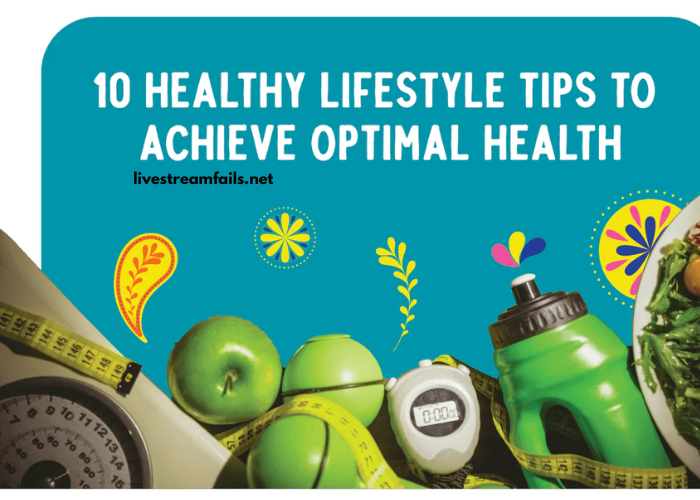Maintaining a balanced and active lifestyle is essential for long-term health and well-being. In today’s fast-paced world, it can be challenging to prioritize self-care, but making small changes to your daily routine can lead to significant health benefits. Whether you’re looking to improve your physical fitness, boost your mental health, or simply feel more energetic, adopting a healthier lifestyle can help you achieve your goals. This article offers practical tips and strategies for maintaining a balanced and active lifestyle that will keep you feeling your best.
Why a Balanced and Active Lifestyle is Important
Before diving into the tips, it’s essential to understand why a balanced and active lifestyle is crucial. A healthy lifestyle helps prevent chronic diseases, improves mental health, boosts energy levels, and enhances overall life satisfaction. Regular physical activity strengthens the heart, bones, and muscles, while a balanced diet supports the body’s functions and maintains healthy weight. In addition to physical benefits, a balanced lifestyle can improve sleep quality, reduce stress, and promote emotional well-being.
Key Components of a Balanced and Active Lifestyle
A balanced and active lifestyle consists of several key components: nutrition, physical activity, mental well-being, sleep, and stress management. Each component plays a significant role in maintaining overall health. In this article, we’ll explore practical tips for each of these areas.
Nutrition: Fuel Your Body Right
Good nutrition is the foundation of a healthy lifestyle. The food you consume provides the nutrients your body needs to function at its best. A well-balanced diet includes a variety of foods, with an emphasis on whole, nutrient-dense options.
1. Focus on Whole Foods
Whole foods, such as fruits, vegetables, lean proteins, whole grains, and healthy fats, provide essential vitamins, minerals, and fiber. Aim to incorporate a wide variety of colorful fruits and vegetables into your meals. These foods are rich in antioxidants, which help protect the body from free radicals and support immune function.
2. Balance Macronutrients
Your body requires three main macronutrients: carbohydrates, proteins, and fats. It’s important to strike the right balance between these macronutrients. Carbohydrates provide energy, proteins are essential for muscle repair and growth, and fats support brain function and hormone production. Including a combination of these macronutrients in each meal can help maintain energy levels throughout the day.
3. Stay Hydrated
Water is essential for maintaining hydration, digestion, and overall bodily functions. Aim to drink at least eight 8-ounce glasses of water per day, or more if you’re physically active or live in a hot climate. Staying hydrated also helps regulate appetite, promotes healthy skin, and supports mental clarity.
Physical Activity: Keep Moving
Exercise is a crucial aspect of an active lifestyle. Regular physical activity not only helps to improve cardiovascular health but also enhances flexibility, muscle strength, and mental well-being.
1. Find an Activity You Enjoy
One of the keys to staying active is finding a form of exercise that you genuinely enjoy. Whether it’s walking, running, cycling, swimming, yoga, or dancing, engaging in physical activity that you love will make it easier to stick to a routine. Experiment with different activities until you find something that excites you.
2. Include Strength and Cardiovascular Exercise
For optimal health, it’s important to incorporate both strength training and cardiovascular exercises into your routine. Strength training helps build and maintain muscle mass, which is essential for metabolism and overall body function. Cardiovascular exercises, such as running, biking, or swimming, are excellent for improving heart health and endurance.
3. Aim for Consistency
Aim to get at least 150 minutes of moderate-intensity exercise per week, or 75 minutes of vigorous activity, as recommended by health experts. If you’re just starting out, you can break this down into smaller sessions, such as 30 minutes of activity five days a week.
4. Include Stretching and Mobility Work
Stretching and mobility exercises help improve flexibility, reduce muscle tension, and prevent injuries. Incorporate dynamic stretches before your workout and static stretches after your workout. Regular yoga or Pilates sessions can also enhance flexibility and promote a sense of calm and relaxation.
Mental Well-Being: Take Care of Your Mind
Mental health is just as important as physical health when it comes to achieving a balanced lifestyle. Managing stress, maintaining a positive outlook, and making time for relaxation are essential for long-term well-being.
1. Practice Mindfulness and Meditation
Mindfulness practices, such as meditation and deep breathing exercises, can help reduce stress, improve focus, and promote a sense of calm. Taking a few minutes each day to engage in mindfulness can positively impact your mood and mental clarity.
2. Stay Connected with Others
Building and maintaining strong social connections is vital for mental well-being. Spend time with loved ones, friends, and family members. Socializing not only boosts your mood but also helps reduce feelings of isolation and loneliness.
3. Manage Stress Effectively
Chronic stress can take a toll on your physical and mental health. Learn how to manage stress through activities like yoga, journaling, or spending time in nature. Regular physical activity can also reduce stress by releasing endorphins, the body’s natural mood boosters.
4. Make Time for Hobbies and Interests
Engaging in hobbies and activities that bring you joy is crucial for maintaining mental well-being. Whether it’s reading, painting, gardening, or traveling, make time for things that allow you to unwind and relax.
Sleep: Rest and Recharge
Quality sleep is essential for a healthy and active lifestyle. Sleep allows your body to repair and regenerate, supports cognitive function, and helps regulate mood.
1. Create a Consistent Sleep Schedule
Going to bed and waking up at the same time each day can help regulate your body’s internal clock, making it easier to fall asleep and wake up feeling refreshed. Aim for 7-9 hours of sleep per night, depending on your individual needs.
2. Create a Sleep-Friendly Environment
Make your bedroom a relaxing environment that promotes restful sleep. Keep the room cool, dark, and quiet, and avoid using electronic devices such as phones or computers before bed. Consider using blackout curtains and white noise machines to enhance your sleep environment.
3. Practice Relaxation Techniques
If you have trouble falling asleep, try relaxation techniques such as reading, deep breathing, or progressive muscle relaxation. These activities can help signal to your body that it’s time to wind down.
Stress Management: Stay Calm and Resilient
Effective stress management is crucial for maintaining both mental and physical health. Chronic stress can contribute to various health problems, including heart disease, obesity, and mental health issues.
1. Prioritize Time for Yourself
In our busy lives, it’s easy to neglect our own needs. Schedule regular “me time” to relax and recharge. Whether it’s taking a walk, enjoying a hobby, or spending time alone, giving yourself space to unwind is vital for reducing stress.
2. Practice Positive Thinking
Adopting a positive mindset can help reduce the negative effects of stress. Practice gratitude by focusing on the positive aspects of your life. Take time each day to reflect on things you’re grateful for, which can shift your focus away from stressors and promote a sense of well-being.
3. Learn to Say No
It’s essential to set boundaries to protect your time and energy. Learning to say no to obligations or activities that overwhelm you can help reduce stress and maintain balance in your life.
Consistency is Key
Achieving a balanced and active lifestyle requires consistency. While it’s okay to have occasional indulgences or take breaks, the key to long-term success is developing habits that support your overall health and well-being. Incorporate small, sustainable changes into your daily routine, and over time, they will become second nature.
Conclusion
Living a balanced and active lifestyle involves a holistic approach that includes nourishing your body with healthy foods, staying physically active, managing stress, getting quality sleep, and nurturing your mental well-being. By focusing on these key areas, you can experience improved health, increased energy, and a greater sense of fulfillment. Remember that small, consistent efforts can lead to long-lasting changes. Start implementing these health tips today, and take the first step toward a healthier, more vibrant life.




